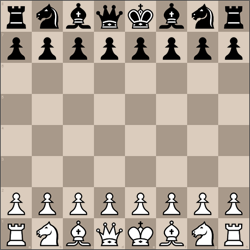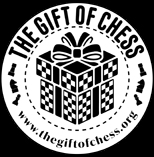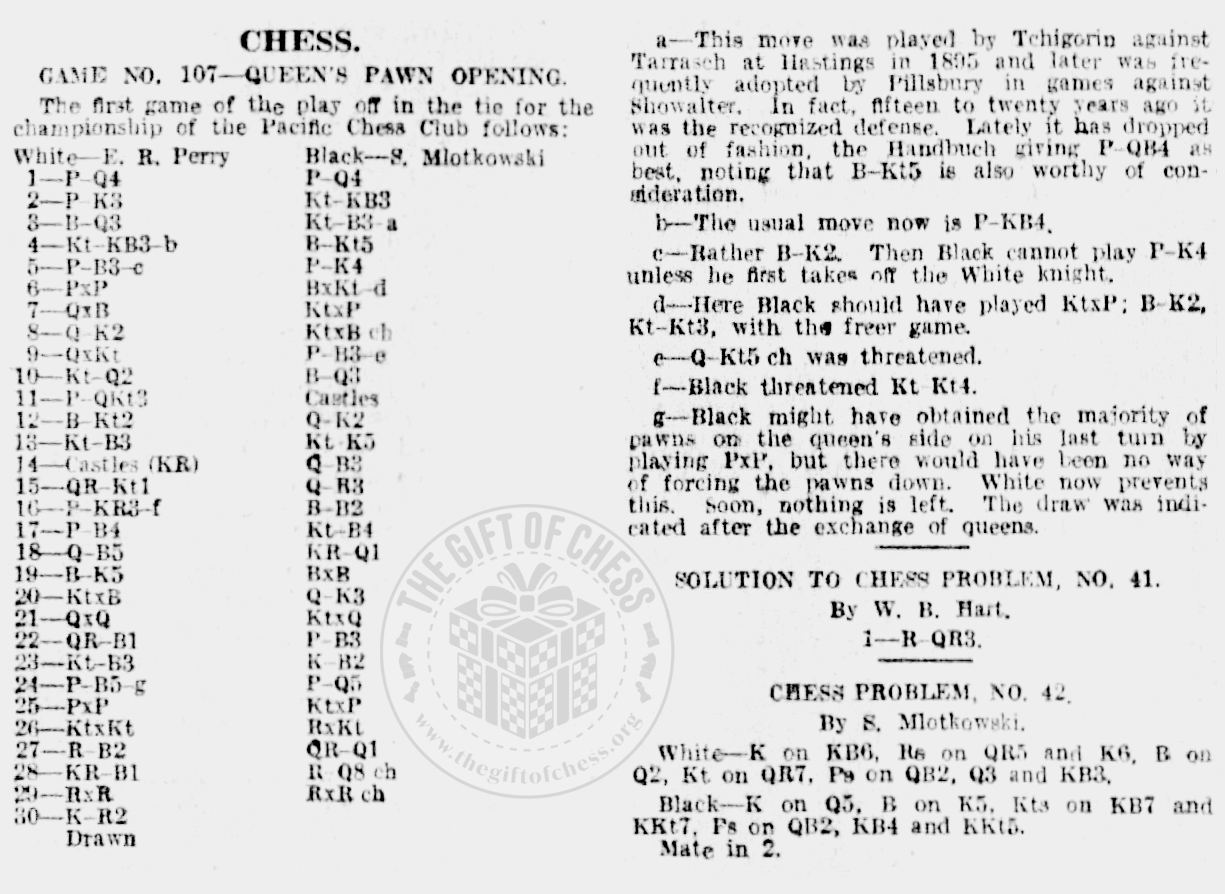< Prev
Index
Next >

MEMBERS OF THE CORNELL CHESS TEAM WHO WON PERMANENT POSSESSION OF THE RICE TROPHY
 Chess 04 Jan 1903, Sun Brooklyn Eagle (Brooklyn, New York) Newspapers.com
Chess 04 Jan 1903, Sun Brooklyn Eagle (Brooklyn, New York) Newspapers.com
Brooklyn Eagle, Brooklyn, New York, Sunday, January 04, 1903, p. 43
Cornell Now Owns Rice Chess Trophy.
Small Margin Decides Triangular College Chess League Tournament.
QUAKERS MAKE A GOOD FIGHT.
Rand of Brooklyn and Mitchell of Manhattan the Successful Team.
The Records.
At the end of the fourth round of the Triangular College Chess League tournament, held at the rooms of the German Press Club during the past four days, the Cornell team emerged victorious for the third consecutive time, ½ a point ahead of the team of the University of Pennsylvania.
Charles L. Rand of Brooklyn and James R. Mitchell of Manhattan, the members of the winning team, scored a total of five games, each tallying 2½ points.
Under the terms of the deed of gift, the trophy, presented by Isaac L. Rice of Manhattan, becomes the permanent property of Cornell. University of Pennsylvania won this emblem in the initial contest, but since then it has been monopolized by the Ithacans.
The final round began at 9 o'clock yesterday morning, with the players paired in the following order:
Rand (C.) vs. Addleman (P.), Smyth (P.) vs. Hicks (B.), Mitchell (C.) vs. Easton (B.)
As Cornell needed only 1 point to clinch the victory, Rand and Mitchell played for a draw and succeeded in attaining the object.
Rand opened hostilities with a Ruy Lopez. Addleman instituted a premature attack and could not avoid a wholesale exchange of pieces. The Pennsylvanian finally made a desperate attempt at forcing the issue, sacrificing two pawns, without, however, getting any equivalent.
With a winning game in hand, Rand proposed a draw, on the thirty-ninth move, which Addleman accepted.
In the second game Cornell was favored by fortune. After repelling Mitchell's attack, Easton assumed the offensive, winning a pawn on the twenty-fifth move. By choosing an inferior continuation he gave Mitchell a chance to recover and a few moves afterward a draw was agreed to.
The game between Smyth and Hicks was evenly contested up to the twenty-fifth move, when Hicks lost a piece by an oversight, and resigned the game.
At a business meeting, held at the conclusion of the tourney, Charles L. Rand, Cornell, was elected president of the league, and Capwell Allen of Brown, another Brooklynite, secretary and treasurer.
Resolutions of thanks were passed to Herman Ridder of the New Yorker Staats-Zeitung, whose guest the collegians were at the German Press Club, and the house committee of that club for the use of the rooms where the games were played.
Another resolution was passed to the effect that the next tournament should be played in New York City on December 30 and 31 and January 1 and 2.
Charles L. Rand of the winning team is well known in local chess circles, being a native of this borough and 20 years old. At different times he has been a member of the Boys' High School Chess Club, Bishops Chess Club and Central Y. M. C. A. Chess Club.
James R. Mitchell is a Manhattan lad of eighteen summers, and a member of the Manhattan Chess Club, in whose handicap tourney he played last year. His acquaintance with the game extends over a period of only three years. He is a freshman at Cornell.
Charles Lyman Rand (white) vs. Samuel Wolf Addleman (black)
Ruy Lopez: Morphy Defense, Classical Defense Deferred
Submitted to chessgames.com on 05/07/2025

Descriptive
1. P-K4 P-K4
2. N-KB3 N-QB3
3. B-N5 P-QR3
4. B-R4 B-B4
5. O-O P-QN4
6. B-N3 P-Q3
7. P-B3 N-B3
8. P-Q4 PxP
9. PxP B-N3
10. B-B2 B-N2
11. N-B3 N-K2
12. B-K3 P-N5
13. P-K5 PxP
14. PxP N-Q2
15. BxB NxB
16. N-QR4 NxN
17. BxNch P-B3
18. QxQch RxQ
19. QR-Q O-O
20. RxR RxR
21. R-Q RxRch
22. BxR P-QB4
23. N-N5 P-R3
24. N-R3 K-B
25. P-B4 N-N3
26. P-KN3 N-K2
27. N-B2 P-B5
28. B-K2 B-Q4
29. N-Q N-B4
30. K-B2 P-QR4
31. P-KN4 N-Q5
32. K-K3 N-B3
33. K-Q2 P-B3
34. PxP PxP
35. N-K3 P-B6ch
36. PxP PxPch
37. KxP BxP
38. N-B5 P-R4
39. PxP B-K3
1/2-1/2 |
Algebraic
1. e4 e5
2. Nf3 Nc6
3. Bb5 a6
4. Ba4 Bc5
5. 0-0 b5
6. Bb3 d6
7. c3 Nf6
8. d4 exd4
9. cxd4 Bb6
10. Bc2 Bb7
11. Nc3 Ne7
12. Be3 b4
13. e5 dxe5
14. dxe5 Nd7
15. Bxb6 Nxb6
16. Na4 Nxa4
17. Bxa4+ c6
18. Qxd8+ Rxd8
19. Rd1 0-0
20. Rxd8 Rxd8
21. Rd1 Rxd1+
22. Bxd1 c5
23. Ng5 h6
24. Nh3 Kf8
25. f4 Ng6
26. g3 Ne7
27. Nf2 c4
28. Be2 Bd5
29. Nd1 Nf5
30. Kf2 a5
31. g4 Nd4
32. Ke3 Nc6
33. Kd2 f6
34. exf6 gxf6
35. Ne3 c3+
36. bxc3 bxc3+
37. Kxc3 Bxa2
38. Nf5 h5
39. gxh5 Be6
1/2-1/2 |
James Ferguson Smyth (white) vs. Leslie Robert Hicks (black)
Ruy Lopez: Closed, Morphy Attack
Submitted to chessgames.com on 05/08/2025

Descriptive
1. P-K4 P-K4
2. N-KB3 N-QB3
3. B-N5 P-QR3
4. B-R4 N-B3
5. O-O B-K2
6. N-B3 O-O
7. P-Q3 P-QN4
8. B-N3 B-N2
9. N-Q5 N-QR4
10. n-K3 NxB
11. RPxN P-Q3
12. N-B5 N-K
13. N-K B-KB3
14. P-KB4 P-N3
15. PxP BxP
16. N-R6ch K-N2
17. N-N4 K-R
18. N-B3 B-N2
19. B-R6 Q-K2
20. BxBch KxB
21. Q-Q2 P-KB3
22. Q-R6ch K-N
23. R-B2 Q-N2
24. Q-R3 P-KR4
25. N-K3 Q-R3
26. N-Q4 N-N2
27. QR-KB P-KN4
28. N(K3)-B5 NxN
29. QxN B-B
30. Q-Q5ch B-K3
31. QxBch Resigns |
Algebraic
1. e4 e5
2. Nf3 Nc6
3. Bb5 a6
4. Ba4 Nf6
5. 0-0 Be7
6. Nc3 0-0
7. d3 b5
8. Bb3 Bb7
9. Nd5 Na5
10. Ne3 Nxb3
11. axb3 d6
12. Nf5 Ne8
13. Ne1 Bf6
14. f4 g6
15. fxe5 Bxe5
16. Nh6+ Kg7
17. Ng4 Kh8
18. Nf3 Bg7
19. Bh6 Qe7
20. Bxg7+ Kxg7
21. Qd2 f6
22. Qh6+ Kg8
23. Rf2 Qg7
24. Qh3 h5
25. Ne3 Qh6
26. Nd4 Ng7
27. Rff1 g5
28. Nf5 Nxf5
29. Qxf5 Bc8
30. Qd5+ Be6
31. Qxe6+ 1-0 |
James Reid Mitchell (white) vs. Stephen Howard Easton (black)
Scotch Game: Schmidt Variation
Submitted to chessgames.com on 05/08/2025

Descriptive
1. P-K4 P-K4
2. N-KB3 N-QB3
3. P-Q4 PxP
4. NxP N-B3
5. NxN NPxN
6. B-Q3 B-K2
7. O-O O-O
8. N-QB3 P-Q3
9. B-K3 N-Q2
10. P-KB4 R-K
11. N-K2 B-B3
12. P-B3 B-N2
13. N-N3 P-B4
14. Q-B2 P-KN3
15. QR-K B-N2
16. P-B5 Q-B
17. PxP RPxP
18. B-QB4 R-B
19. B-KN5 B-QR3
20. BxB QxB
21. P-QR3 N-K4
22. B-B6 QR-N
23. P-B4 Q-N3
24. R-K2 Q-N6
25. BxN BxB
26. R-B3 QxQ
27. RxQ RxP
28. RxR BxR
29. R-N3 B-Q5ch
30. K-B R-R
31. R-N7 P-B3
32. R-B7 1/2-1/2 |
Algebraic
1. e4 e5
2. Nf3 Nc6
3. d4 exd4
4. Nxd4 Nf6
5. Nxc6 bxc6
6. Bd3 Be7
7. 0-0 0-0
8. Nc3 d6
9. Be3 Nd7
10. f4 Re8
11. Ne2 Bf6
12. c3 Bb7
13. Ng3 c5
14. Qc2 g6
15. Re1 Bg7
16. f5 Qc8
17. fxg6 hxg6
18. Bc4 Rf8
19. Bg5 Ba6
20. Bxa6 Qxa6
21. a3 Ne5
22. Bf6 Rab8
23. c4 Qb6
24. Re2 Qb3
25. Bxe5 Bxe5
26. Rf3 Qxc2
27. Rxc2 Rxb2
28. Rxb2 Bxb2
29. Rb3 Bd4+
30. Kf1 Ra8
31. Rb7 c6
32. Rc7 1/2-1/2 |
The final team totals were as follows:
Colleges
Cornell......... 5 - 3
Pennsylvania.... 4½ - 3½
Brown........... 2½ - 5½
The individual scores were:
Mitchell........ 2½ - 1½
Rand............ 2½ - 1½
Addleman........ 2½ - 2½
Smyth........... 2 - 2
Easton.......... 2 - 2
Hicks........... ½ - 3½
The records of the four tournaments thus far contested are appended:
Year Cornell U of P. Brown
1899............ 5½ 6 ½
1900............ 5½ 3 3½
1901............ 4½ 2½ …
1902............ 5 4½ 2½
Brown was not represented in the tourney of 1901.
 Chess 06 Mar 1904, Sun San Francisco Chronicle (San Francisco, California) Newspapers.com
Chess 06 Mar 1904, Sun San Francisco Chronicle (San Francisco, California) Newspapers.com













































